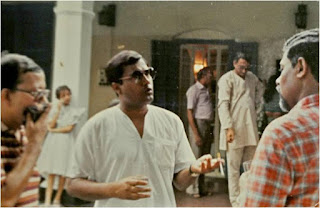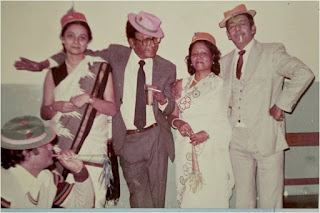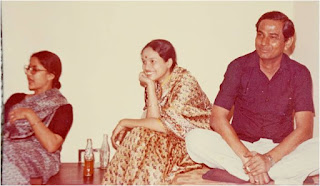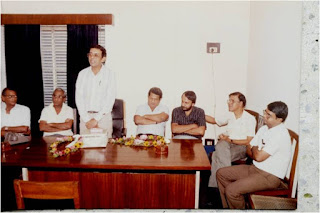DUNLOP
SAHAGANJ
A
Nostalgic journey down memory lane
I joined Dunlop India’s Sahaganj
factory in Sept. 1971, and was living at Lat Bagan, which was about 1 km from
the factory.In August 1972 Titli was born at the Dunlop hospital. Purobi and me
along with Titli, who was just about a year old, shifted to the Dunlop Estate
in Sept 1973. We were given a small but cozy, newly built flat at the back of
the Dunlop Tennis Club. The CRP camp was behind our flat, and that gave us
security.
We were the first ones to move in to
that locality which was at the rear end of the Estate, tucked away from the
hum-drum of the inhabitants living on the Link road. Following us Taposh&
Binita Sarcar along with their son Ronju moved in adjacent to our flat.
 |
Titli & Ronju Sarcar ----- the
first toddlers in Chetla
|
Later Ashok Dasgupta and Tutu along
with their son Joy moved in to a flat above us.
Gradually Monu Puranesh, B M Basu, D K Banerji,
Khullar, Subir Sengupta, Arnab Bhattacharya, Arup Deb, Kanai Choudhuryand
others moved in. The families coalesced into a small community. Like minded
families also joined the neighborhood; most active amongst them were Sailen
& Pranati Roy Choudhury. Harry Sen & Subir Sengupta moved in with their
new wives. Purobi, Tutu and Binita gave them the traditional Bengali welcome
given to new brides. All the new flats were occupied within 2 years. Most of us
had a toddler or two, and surely the stork visited our locality often with
bundles of joy. Work in the factory was not stressful, and the ladies soon
formed their own group, oblivious of the Dunlop Ladies Club which was headed by
the GWM’s wife. The GWM at that time was Arthur Smith. Entertainment outside
the campus were far and few, but we enjoyed and made merry with frequent pool dinners,
pot luck parties and picnics by the old pond, or nearby gardens. We even organised and staged “Borsha Mongol”
at the Dunlop Cinema Hall. While the ladies were busy with the toddlers, we men
tried our best to be good fathers.
An old pond at the end of our row of
flats provided us excitement. We made bamboo fishing rods, bought fishing hooks
& strings. Bhiku,Subir’s man-Friday made the fishing tackles and the bait
was simply flour dough, and he taught us fishing too. On holidays ladies and
gents gathered around the old pond to fish. Though our catch was not worth
mentioning, but the chain supply of hot Pakoras and coffee provided by Mitra
Sengupta and Sudha Puranesh made such adventures very entertaining. By mid-1975
the community started calling itself the Chetla Gang.
Basab Sen became the president, and me
the secretary of the Dunlop Tennis Club in 1975. When I took over, the coffers of the club had
money just enough to pay the staff which comprised of Zakir, Nirmal, bar man
Ram-babu, and Raju the billiard marker. I sold the unused billiard table,
raised the price of the drinks, and soon we had money to increase the value of
the prizes given to winners of the various competitions, added books to our
library, and started holding lavish club nights and new year parties with live
band and a crooner.. We had a very pro-active young committee, of whom Sujit
Baul was a tireless enthusiast. By this time many young management graduates
had joined, the Bower was full, and the club became buzzing with sports and
cultural activities. We even got the then famous Chuni Goswami to our club.
Unfortunately I don’t have pictures of that day.
 |
| Manju Chak receiving a prize from our then GWM Arthur Smith. |
 |
| Titli’s birthday 1976 - gathering of kids. Most are today beautiful ladies and gents in high corporate jobs. Spot yourselves. |
.
By 1975, many of us moved to bigger
flats on the link road. Nevertheless, the spirit and friendship within the
Chetla Gang bloomed. Many more joined in. The kids grew, new arrivals added,
and pressures in the factory remained congenial.
The biggest event in the
Chetla calendar became the Saraswati Puja. The management was gracious enough
to lend us an empty flat, and for 2 days it was just fun and fun. In fact the
excitement started building at the planning stage. The ladies did all the
marketing, we boughta mid-sized idol from Hooghly, and Komol-da was our cook,
later when the crowd became large, caterers were employed. On the “Chothurti”
we had egg-curry for dinner. Later we used to call it “Deem Chothurti”. On the
“Ponchomi day” it was strictly vegetarian. The evening was about kids
performing and elders dancing. For the “Bhasaan” we used to take the idol
around the estate shouting slogans ---“aasche bochhor abaar hobe”, to the
Ganges Ghat. Later we had Mutton curry & rice before dispersing. This
Saraswati Puja grew bigger and bigger every year, and luckily
we got bigger flats to celebrate.
 |
The kids always presented some dance items or skits. And the elders had fun dancing.
|
By the end of 1979, Mr.
Raj Bhandari took over as the Works Director. There were many changes in the
top management in the factory. The factory started modernizing, and pressure
started mounting. Inter-department tolerance narrowed, and friction with the unions
became sharp. But, life in the Estate, especially amongst our Chetla Gang,
remained joyful. We continued to have “Khat Parties” and the growing kids were
encouraged to hold performances.
The week-end golf
trickled to 4-5 members when in one of the annual Golf Club (I was the
secretary for 10 years) parties Mr. Bhandari announced that golf did not bring
promotions.
The kids celebrated
Rabindra Jayanti. The ladies worked hard to train the kids to organise cultural
functions. We men provided the structural support only, and hid our rum in Coca-Cola.
 | ||
Apu makes a point much to
the chagrin of Sona.
|
 |
| Moon took on the responsibility of choreographing the young dancers |
When I joined Dunlop, I
was not acquainted with either Golf or Horse racing. The euphoria regarding
both started from Thursday every week. I was told,even the GWM asked for racing
tips while on his morning rounds. The pseudo British Culture comprising the
Native Shaabs was also new to us. There were the Chatterjees, Mukherjees, Sens,
Raos, Malhotras, Kapoors etc etc who were born and brought up in native India
but behaved as if they came straight from the Buckingham Palace. Coming from a
traditional middle-class Bengali family, and after spending the 1st
five years of my job-life in a PSU it took me long to get familiar to the new
world. But, when we got familiar with the Saab People we found that beneath
their veneer they were all normal likeable Indians.
On Saturdays, Purobi
took a rickshaw from Lat Bagan to the Bandel station. While I had a quick lunch
at the Bower and took a bus to catch the 1:28 PM Bandel local to Howrah.
Incidentally, that was nick-named as the “Race Train” amongst the Punters from
the factory. The Bower was then full of youngsters and most had a fascination-it
was about the Compound where the senior officers& their families lived,
which had high boundary walls and a huge manned iron gate. There was an awe and
mystery surrounding the Compound.
We and some others moved
to the Compound in 1987.Arnab & his family had moved in earlier. The
Compound was maintained like a garden --- trimmed hedges, manicured lawns,
flowering trees, and the Ganges flowing along the outer boundary. It had its
own exclusive club and a bar. I was promptly made the Club Secretary. Initially
we found the Compound boring, sedate and most had a tight upper lip. The ladies
moved around like the characters of Tagore’s “Tasher Desh”.
To break the monotony I
organised a Barbeque Night. The ladies took keen interest. I got a Barbeque
oven and skewers made in the factory. (being an Engineer had many advantages),
the cook Abdul & bearers did the marketing under the guidance of the
ladies. And we had a grand Barbeque Party by the riverside.
 |
Ladies cook Sheek Kababs under the watchful eyes of the club bearer Abdul.
|
Holi was celebrated with enthusiastic fervor.
 |
| Boys stoke the Holi Fire the night before. |
 |
| Men enjoy their drinks by the fire. |
 |
| Kids & ladies play Holi |
 |
| Relaxing after Holi play |
Basanta Utsav in the Compound - these
were unheard of in the earlier years
And work goes on . . .
 |
| Arindam Datta discusses a point with Monu Abraham |
 |
| B M Basu and me with Japanese Officials. |
Compound Club
get-togethers and parties continue
New Year Party Dance competition - the game was to give the MC something away every time the music stopped. It started by members giving hanky, belts, shoes, socks etc etc. Near the fag end I found late Chandi Mullick and me as the remaining dancers on the floor, both of us in our trousers only.
 |
Late Chandi Mullick dresses back
|
The next time music
stopped, I quickly snatched Liza’s shawl, wrapped it around myself and gave away
my pants. I won. Pic shows an embarrassed Liza, and me very happy.
Christmas Party
The Strike period – 1988 - the strike continued for nearly 3 months.
 |
We occasionally had parties with the kids performing. |
Left Dunlop Sahaganj in
Oct 1990.






























































